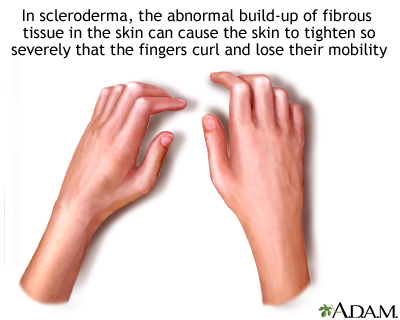Collagen vascular disease
In a class of diseases known as autoimmune disorders, the body's immune system attacks its own tissues. Some of these diseases are similar to each other. They may involve arthritis and inflammation of arteries in the tissues. People who developed these disorders were previously said to have "connective tissue" or "collagen vascular" disease. We now have names for many specific conditions such as:
Autoimmune disorders
An autoimmune disorder occurs when the body's immune system attacks and destroys healthy body tissue by mistake. There are more than 80 autoimmune d...

-
Ankylosing spondylitis
Ankylosing spondylitis
Ankylosing spondylitis (AS) is a chronic form of arthritis. It mostly affects the bones and joints at the base of the spine where it connects with t...
 ImageRead Article Now Book Mark Article
ImageRead Article Now Book Mark Article -
Dermatomyositis
Dermatomyositis
Dermatomyositis is a disease that involves muscle inflammation and a skin rash. Polymyositis is a similar inflammatory condition that also involves ...
 ImageRead Article Now Book Mark Article
ImageRead Article Now Book Mark Article -
Polyarteritis nodosa
Polyarteritis nodosa
Polyarteritis nodosa is a serious inflammatory blood vessel disease. The small and medium-sized arteries become swollen and damaged.
 ImageRead Article Now Book Mark Article
ImageRead Article Now Book Mark Article - Polymyositis
-
Psoriatic arthritis
Psoriatic arthritis
Psoriatic arthritis is a joint problem (arthritis) that often occurs with a skin condition called psoriasis.
 ImageRead Article Now Book Mark Article
ImageRead Article Now Book Mark Article -
Rheumatoid arthritis
Rheumatoid arthritis
Rheumatoid arthritis (RA) is a disease that leads to inflammation of the joints and surrounding tissues. It is a long-term disease. It can also aff...
 ImageRead Article Now Book Mark Article
ImageRead Article Now Book Mark Article -
Scleroderma
Scleroderma
Scleroderma is a disease that involves the buildup of fibrous tissue in the skin and elsewhere in the body. It also damages the cells that line the ...
 ImageRead Article Now Book Mark Article
ImageRead Article Now Book Mark Article -
Systemic lupus erythematosus
Systemic lupus erythematosus
Systemic lupus erythematosus (SLE) is an autoimmune disease. In this disease, the immune system of the body mistakenly attacks healthy tissue. It c...
 ImageRead Article Now Book Mark Article
ImageRead Article Now Book Mark Article - Mixed connective tissue disease
- Relapsing polychondritis
- Vasculitis
When a specific disease cannot be diagnosed, more general terms may be used. These are called undifferentiated systemic rheumatic (connective tissue) diseases or overlap syndromes.
Reviewed By
Neil J. Gonter, MD, Assistant Professor of Medicine, Columbia University, NY and private practice specializing in Rheumatology at Rheumatology Associates of North Jersey, Teaneck, NJ. Review provided by VeriMed Healthcare Network. Also reviewed by David C. Dugdale, MD, Medical Director, Brenda Conaway, Editorial Director, and the A.D.A.M. Editorial team.
Graf J. Overlap syndromes. In: Firestein GS, Budd RC, Gabriel SE, Koretzky GA, McInnes IB, O'Dell JR, eds. Firestein & Kelley's Textbook of Rheumatology. 11th ed. Philadelphia, PA: Elsevier; 2021:chap 91.
Teegavarapu SP, Mims MP. Lymphocytosis, lymphocytopenia, hypergammaglobulinemia, and hypogammaglobulinemia. In: Hoffman R, Benz EJ, Silberstein LE, et al, eds. Hematology: Basic Principles and Practice. 8th ed. Philadelphia, PA: Elsevier; 2023:chap 50.
Disclaimer






 All rights reserved.
All rights reserved.